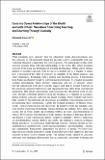| dc.contributor.author | Cavicchi, Elizabeth | |
| dc.date.accessioned | 2024-07-11T21:22:07Z | |
| dc.date.available | 2024-07-11T21:22:07Z | |
| dc.date.issued | 2024-06-23 | |
| dc.identifier.issn | 0826-4805 | |
| dc.identifier.issn | 1573-1790 | |
| dc.identifier.uri | https://hdl.handle.net/1721.1/155663 | |
| dc.description.abstract | What potentials does curiosity bear for education? Some characterizations portray curiosity as self-motivated search for answers, a drive conformable with conventional education’s imperative for correct answers. For participants in this study, curiosity engages them with their relationships to the world. This article examines curiosity from along my developing in learning and teaching. While school settings limited or excluded curiosity, both for me as a student and as a teacher, it relates how I encountered the value of curiosity in examples of my father, mentors, and other experiences. Beginning with a gradual and uncertain process, I transitioned from being an educator bound by conventional expectations, to a teacher-researcher creating environments where learners’ expressions and acts of curiosity constitute the educational work that I actively support and seek to extend. Curiosity in the classroom generates trajectories and engagements that differ from conventional instruction. This article demonstrates and researches the educational work of curiosity, through contextual narratives from my teaching as a beginner at accommodating students’ curiosity, and from my recent teaching, where students and I more fully commit to the relational and educational possibilities of encouraging curiosity. In facilitating these experiences, I apply the research pedagogy of Eleanor Duckworth, ‘critical exploration in the classroom’. In narratives from my teaching, curiosity propels exploring relationships among: floating and sinking; trees, leaves and acorns; dye in water; maple sap sweetness; bubbles in water; and permutations of objects. Provocations from historical works include: Leonardo’s drawings; Hooke’s and Ramón y Cajal’s microscopy; Keats’ “negative capability”; Dewey’s reflections on interdependency among children and adults; and children’s creations in Reggio Emilia preschools. As experience builds through curiosity, relations deepen in ways simultaneously unadulterated—exploring unconstrained—and unchildlike—sustaining commitment. Participants characterize our process as having “No End Goal” imposed from outside themselves, unlike formal instruction that suppresses personal curiosity in favor of pre-ordained goals. The natural world, opened by curiosity, embodies ever-emerging relationships that accommodate concurrent widening and deepening of learners’ involvement and realizations. Learning experiences happening through relationships are infused with emotion, aesthetic qualities, and social connections and concerns. | en_US |
| dc.publisher | Springer Science and Business Media LLC | en_US |
| dc.relation.isversionof | 10.1007/s10780-024-09529-8 | en_US |
| dc.rights | Creative Commons Attribution | en_US |
| dc.rights.uri | https://creativecommons.org/licenses/by/4.0/ | en_US |
| dc.source | Springer Netherlands | en_US |
| dc.title | Curiosity Opens Relationships of the World and with Others: Narratives from Doing Teaching and Learning Through Curiosity | en_US |
| dc.type | Article | en_US |
| dc.identifier.citation | Cavicchi, E. Curiosity Opens Relationships of the World and with Others: Narratives from Doing Teaching and Learning Through Curiosity. Interchange (2024). | en_US |
| dc.contributor.department | Edgerton Center (Massachusetts Institute of Technology) | |
| dc.identifier.mitlicense | PUBLISHER_CC | |
| dc.eprint.version | Final published version | en_US |
| dc.type.uri | http://purl.org/eprint/type/JournalArticle | en_US |
| eprint.status | http://purl.org/eprint/status/PeerReviewed | en_US |
| dc.date.updated | 2024-06-30T03:10:51Z | |
| dc.language.rfc3066 | en | |
| dc.rights.holder | The Author(s) | |
| dspace.embargo.terms | N | |
| dspace.date.submission | 2024-06-30T03:10:51Z | |
| mit.license | PUBLISHER_CC | |
| mit.metadata.status | Authority Work and Publication Information Needed | en_US |
